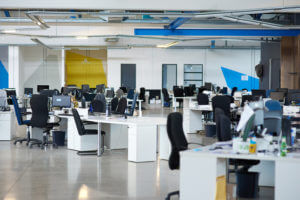 It’s no surprise that the U.S. spends 13 percent of its energy heating and cooling buildings. But, unfortunately, much of the energy goes to changing temperatures in areas where people aren’t located. Like an empty room…or the ceiling. Many office buildings focus on the structure rather than the occupants inside. Therefore, saving energy in the office and occupant comfort levels are often sacrificed.
It’s no surprise that the U.S. spends 13 percent of its energy heating and cooling buildings. But, unfortunately, much of the energy goes to changing temperatures in areas where people aren’t located. Like an empty room…or the ceiling. Many office buildings focus on the structure rather than the occupants inside. Therefore, saving energy in the office and occupant comfort levels are often sacrificed.
In response, the Department of Energy established the DELTA Program (“Delivering Efficient Local Thermal Amenities”) to reduce the costs for heating and cooling buildings by introducing Localized Thermal Management Systems (LTMS). These approaches potentially enable an energy savings in the office upwards of 2%.
Saving Energy in the Office with Localized Thermal Management Systems
Over-conditioning or over-heating a building creates major inefficiencies in building operations. Don’t waste energy or sacrifice comfort. To address these inefficiencies, energy management strategies use minimal energy when/where it’s not needed. Some building owners already use occupancy sensors to turn off lights and adjust HVAC temperatures in unoccupied office spaces.
Other buildings have made great strides at saving energy in the office. This includes developing technological designs such as Localized Thermal Management Systems. LTMS’s goal is to reduce waste by modifying the physical space surrounding the human body (rather than an entire building). Thus providing energy savings in the office for both new and old buildings.
The new technologies include innovative devices such as fabrics that adjust thermal properties, in addition to chairs, robots and vents all designed to make occupants feel more comfortable and lead to energy savings. These efforts enable building operators to ensure occupant comfort while reducing energy consumption and emissions for the entire office space.
Saving Energy in the Office through LEED
It can be challenging to focus on ways to efficiently heat or cool large areas while dealing with occupancy changes, especially throughout an average day or week and even throughout the year. Although more commercial sectors are adopting new energy-efficient HVAC technologies such as LTMS, several other building systems are already making an impact, such as the LEED certification.
The Leadership in Energy & Environmental Design (LEED) building certification program is often a first step toward ensuring occupant comfort levels and saving energy in the office. It provides independent verification of a building’s sustainable features. This is based on thermal comfort, acoustics, indoor air quality (IAQ), lighting, building cleanliness, etc.
Interested in pursuing your LEED certification? At KMB, our philosophy is first to understand, then provide appropriate solutions and designs. Whether you’re looking to decrease energy costs and improve efficiency in an office building, restaurant, government building, hospital, museum, shopping plaza, educational institution, grocery store, industrial building, convention center or airport, we can create an energy solution that’s specific to your exact needs.
Contact us at 855-75-KMBDG (855-755-6234) to start saving energy in the office today.